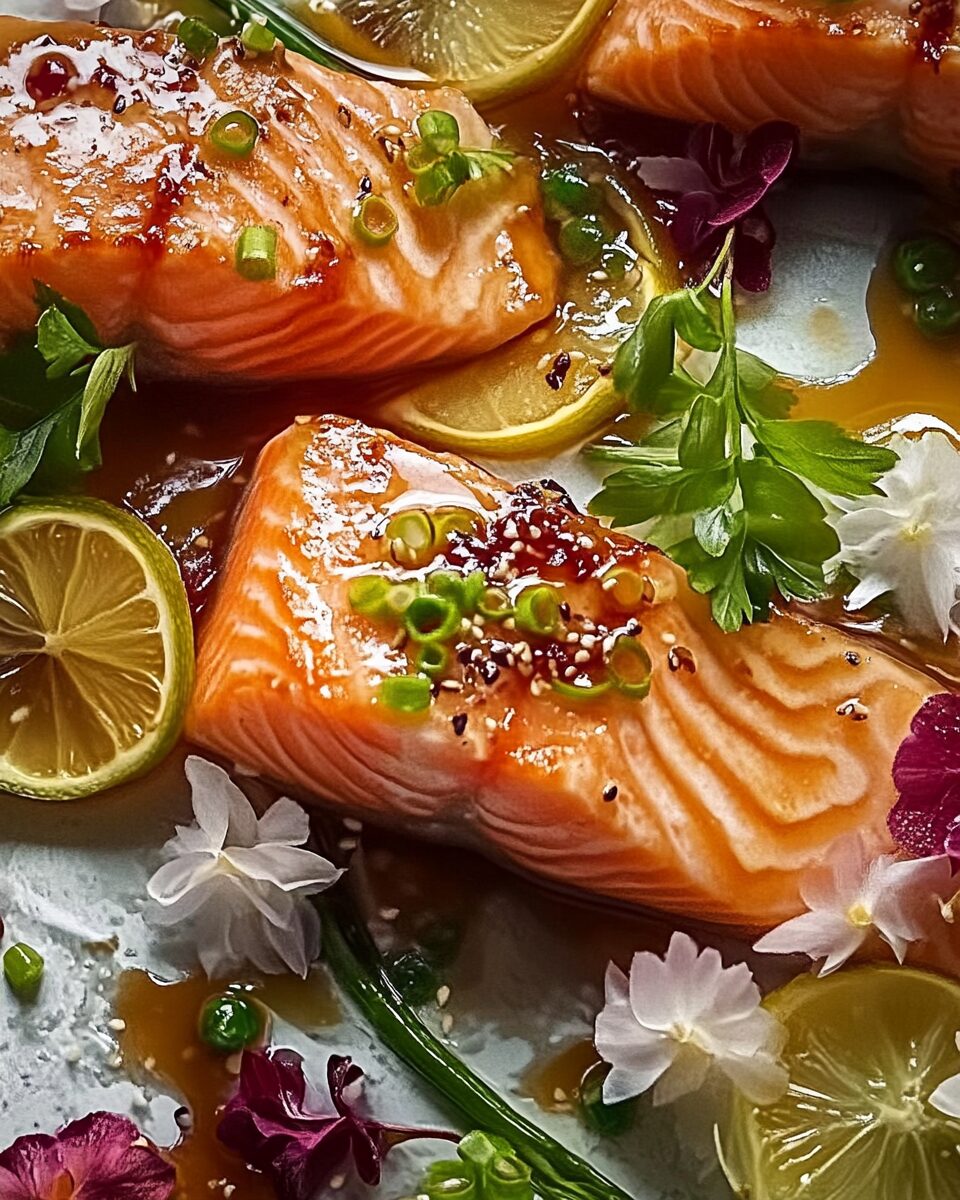This Baked Teriyaki Salmon is a flavorful, easy-to-make dish that balances sweet and savory flavors. The salmon is marinated in a delicious teriyaki sauce with hints of garlic and ginger, creating a restaurant-quality meal perfect for any occasion.
FULL RECIPE
Ingredients
- 4 fresh salmon fillets (6 oz each)
- 1/2 cup teriyaki sauce
- 2 cloves garlic, minced
- 1 tsp fresh ginger, grated
- 2 tbsp brown sugar or honey
- 1 tsp sesame oil
- 2 green onions, thinly sliced for garnish
- 1 tbsp sesame seeds (optional)
Directions
- Preheat the oven to 400°F (200°C).
- Whisk together teriyaki sauce, garlic, ginger, brown sugar (or honey), and sesame oil.
- Marinate salmon fillets in the sauce for 30 minutes to 2 hours.
- Line a baking sheet with parchment paper and place the salmon on it.
- Pour remaining marinade into a saucepan and simmer for 5 minutes.
- Bake salmon for 12-15 minutes, brushing with glaze during the last few minutes.
- Garnish with green onions and sesame seeds.
Nutritional Information
- Calories: 365 kcal
- Protein: 22g
- Carbs: 14g
- Fat: 23g
The Appeal of Baked Teriyaki Salmon
The allure of Baked Teriyaki Salmon lies in its harmonious balance of flavors and textures. The teriyaki glaze, with its sweet and umami undertones, complements the natural richness of the salmon, resulting in a dish that’s both indulgent and wholesome. Baking the salmon ensures it remains moist and tender, while allowing the flavors to meld beautifully.
Health Benefits of Omega-3 Fatty Acids
Omega-3 fatty acids, abundantly found in salmon, play a crucial role in reducing inflammation, lowering blood pressure, and decreasing the risk of heart disease. Regular consumption of omega-3s has also been linked to improved cognitive function and a reduced risk of neurodegenerative diseases.
The Role of Teriyaki Sauce in the Dish
Teriyaki sauce, a staple in Japanese cuisine, is typically made from a blend of soy sauce, mirin, sugar, and ginger. This sauce imparts a glossy finish and a depth of flavor to the salmon, enhancing its natural taste. The sweetness of the teriyaki balances the savory notes of the fish, creating a well-rounded flavor profile.
Customizing the Teriyaki Sauce
One of the advantages of making teriyaki sauce at home is the ability to adjust its components to suit personal preferences. For a sweeter sauce, one might increase the sugar or honey content; for a more savory profile, adding more soy sauce can be beneficial. Incorporating ingredients like garlic or sesame oil can also introduce additional layers of flavor.
Pairing Baked Teriyaki Salmon with Side Dishes
Baked Teriyaki Salmon pairs wonderfully with a variety of side dishes. Steamed jasmine or basmati rice serves as a neutral base that absorbs the flavorful sauce. For a low-carb alternative, cauliflower rice or quinoa can be used. Additionally, roasted or steamed vegetables like broccoli, asparagus, or green beans complement the dish’s flavors and add nutritional value.
Incorporating Greens for a Balanced Meal
Adding leafy greens such as sautéed spinach or kale not only enhances the visual appeal of the meal but also boosts its fiber and micronutrient content. These greens provide a slight bitterness that contrasts nicely with the sweetness of the teriyaki sauce.
The Importance of Marination
Marinating the salmon allows the flavors of the teriyaki sauce to penetrate the fish, resulting in a more flavorful dish. A marination period of 30 minutes to an hour is typically sufficient. However, it’s advisable not to exceed two hours, as prolonged exposure to acidic components in the marinade can alter the texture of the fish.
Baking vs. Pan-Searing
While baking is a popular method for preparing teriyaki salmon due to its ease and even cooking, pan-searing is another viable option. Pan-searing can yield a crispy exterior, adding a different textural element to the dish. However, it requires careful attention to prevent overcooking.
Achieving the Perfect Bake
To ensure the salmon is cooked to perfection, preheating the oven to 400°F (200°C) is recommended. Baking time varies depending on the thickness of the fillets but generally ranges from 12 to 15 minutes. The goal is to achieve an internal temperature of 145°F (63°C), at which point the salmon should flake easily with a fork.
Glazing for Enhanced Flavor
Brushing the salmon with additional teriyaki sauce during the final minutes of baking enhances its flavor and imparts a glossy finish. This step also helps to caramelize the sugars in the sauce, adding depth to the dish.
Garnishing for Presentation and Taste
Garnishing the baked teriyaki salmon with sliced green onions and toasted sesame seeds adds both visual appeal and a subtle crunch. These garnishes introduce fresh and nutty notes that complement the rich flavors of the dish.
Storing and Reheating Leftovers
Leftover baked teriyaki salmon can be stored in an airtight container in the refrigerator for up to two days. To reheat, placing the salmon in a skillet over medium-low heat with a splash of water and covering it can help retain moisture. Alternatively, gentle reheating in the microwave is also effective.
Incorporating Leftovers into New Dishes
Flaked leftover salmon can be repurposed into various dishes, such as salads, fried rice, or grain bowls. This versatility makes baked teriyaki salmon an excellent choice for meal prepping.
Adapting the Recipe for Dietary Restrictions
For those adhering to gluten-free diets, substituting traditional soy sauce with tamari or coconut aminos ensures the dish remains gluten-free. Similarly, using a sugar substitute or reducing the amount of sweetener can cater to those monitoring their sugar intake.
Exploring Variations of the Dish
Incorporating additional ingredients like pineapple slices or bell peppers can introduce new flavors and textures to the dish. These additions can provide a sweet and tangy contrast to the savory salmon.
The Cultural Significance of Teriyaki
Teriyaki is a cooking technique that originated in Japan, characterized by grilling or broiling foods with a glaze of soy sauce, mirin, and sugar. Over time, this technique has evolved and adapted into various cuisines around the world, with Baked Teriyaki Salmon being one of the most beloved adaptations.
Salmon Sustainability and Sourcing
When selecting salmon for this dish, it is important to consider its source. Wild-caught Alaskan salmon is often considered the most sustainable option, while responsibly farmed salmon can also be a good choice. Knowing where your fish comes from helps support environmentally sound practices.
Making the Dish Kid-Friendly
To make Baked Teriyaki Salmon more appealing to children, consider reducing the amount of ginger and using a slightly sweeter glaze. Cutting the salmon into bite-sized portions or serving it with fun sides like sweet potato fries or corn on the cob can also make it more attractive to young eaters.
Pairing with Beverages
Baked Teriyaki Salmon pairs well with a range of beverages. For a non-alcoholic option, green tea or sparkling water with lemon works beautifully. Wine enthusiasts might enjoy a glass of chilled white wine, such as Sauvignon Blanc or Chardonnay, which complements the dish’s flavor profile.
Conclusion
Baked Teriyaki Salmon is not just a meal—it’s a celebration of flavors, nutrition, and simplicity. Its ability to cater to different tastes and dietary needs, combined with its nutritional benefits, makes it a top contender for weeknight dinners and special occasions alike. By customizing the sauce, playing with accompaniments, and exploring sustainable sourcing, you can elevate this classic recipe to new culinary heights. Whether you’re cooking for one or a crowd, this dish is sure to satisfy and impress.






